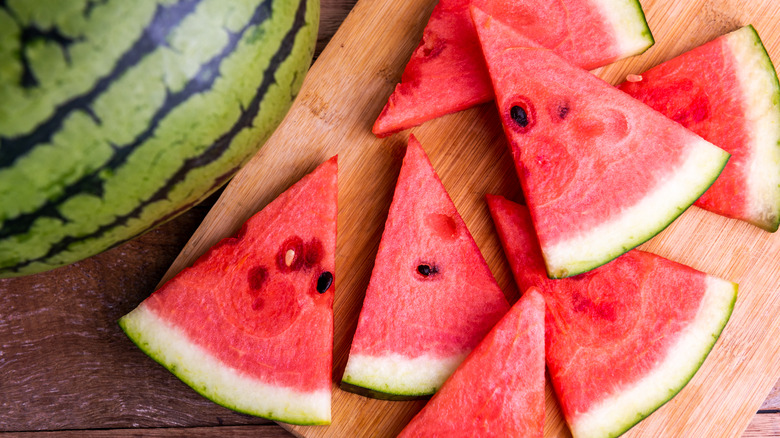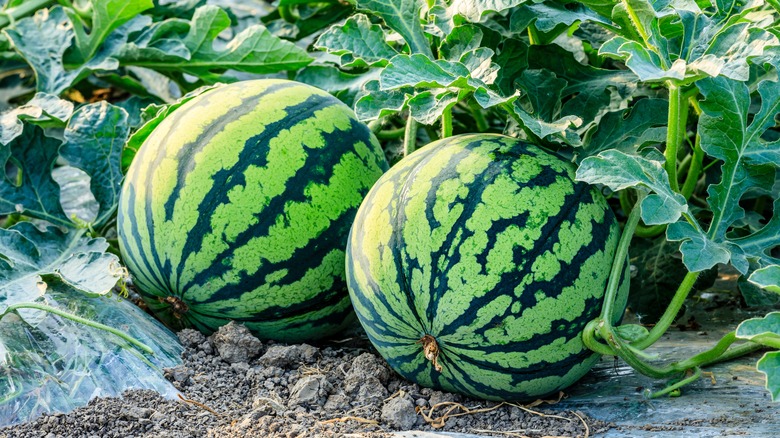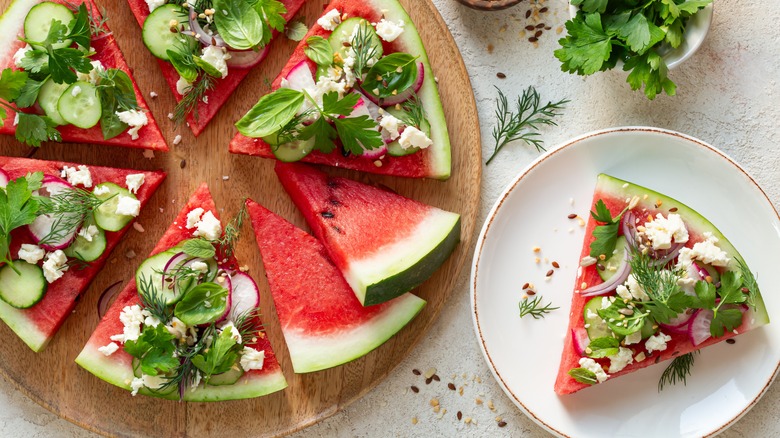Where Does The US Watermelon Supply Come From In Winter?
Capable of feeding a crowd, watermelons are quite a popular pick — in fact they are the favorite melon in the United States, with 14.1 pounds available per person in 2022, per the USDA. But they aren't just for picnics, or just for summer for that matter. While it is true that most watermelons are consumed in the summer months, where huge bins full of fresh melons overwhelm the produce section of local grocery stores, they are also a favorite in the winter. Which begs the question: Where exactly are they being grown during the winter months that makes them accessible year-round?
Watermelons are grown domestically during the summer in a variety of states, most of them in the south. But as the temperatures cool and domestic production drops off, however, new sources are needed to meet the year-round demand for the fruit. Much like other produce available in the off-season, countries south of the border such as Mexico, Brazil, and the Dominican Republic are largely responsible for the watermelons you find for sale in the winter.
Why we have watermelons year-round
According to the National Watermelon Promotion Board, the fruit is grown commercially in 30 U.S. states in all during the months of May through September. While the usual agricultural giants are well-represented here — think Florida, California, Texas, and Georgia — there are actually some watermelon-producing states that may come as a surprise, including Delaware and Indiana. If you buy a watermelon during these months, the chances are good that it was grown domestically.
In the off-season, not so much. Watermelons like the warmth, and need 8-10 hours of direct sunlight a day to mature. And the only way they are going to find this environment during the winter months is south of the border. Mexico is a massive producer of watermelons nearly year-round, accounting for around 80% of annual U.S. imports. Other central American countries such as Costa Rica, Honduras, and Guatemala are also big growers of watermelons, as is Brazil in South America, and the Caribbean nation of the Dominican Republic.
When ready, winter watermelons are shipped north, where you'll be able to find them in the produce aisle of your local grocer (no farmer's markets for these picks). Since shipping time can be more lengthy than in the summer months, you'll want to take care to select a melon that is at the peak of ripeness. Some things to look for include a palpable heaviness (meaning more water content, and hence more sweetness), a darker or duller skin (also a sign of ripeness), and an orange — rather than white — field spot, which will usually indicate that the melon was on the vine longer, and as such, will tend to be sweeter.
Why you should eat watermelon all year
Watermelons are largely popular because they are so succulent and tasty, a sharp contrast to historical versions of the fruit, which tended to be firm and bitter or bland (which is a big reason why ancient people actually hated the taste of watermelon). From a culinary standpoint, you can also do a lot with them.
The fruit is featured prominently at many outdoor get-togethers, where they are eaten raw or in salads, and can even be thrown on the grill (yes, you can sear grill marks into watermelon!). When the weather chills, they can be juiced and served in cocktails, or you can have fun and create your own concoctions, such as watermelon pizza.
Watermelon also provides a number of health benefits, starting with its hydrating qualities. With its proportion of water weight at 92%, eating watermelon at any time of the year is a great way to keep your water and electrolyte levels up (although eating watermelon isn't quite the same as drinking water). It is a good source of the non-essential amino acid citrulline, which can help your body in a variety of areas, including getting rid of ammonia and other harmful substances. Watermelon also contains the antioxidant lycopene, which research has shown can help to protect against heart disease, as well as some cancers, according to Healthline. So, if winter weather has you down and you need a quick burst of summer to keep you going, try slicing open a watermelon.



